Robert Gerstenberger
Reasoning Language Models: A Blueprint
Jan 20, 2025Abstract:Reasoning language models (RLMs), also known as Large Reasoning Models (LRMs), such as OpenAI's o1 and o3, DeepSeek-V3, and Alibaba's QwQ, have redefined AI's problem-solving capabilities by extending large language models (LLMs) with advanced reasoning mechanisms. Yet, their high costs, proprietary nature, and complex architectures - uniquely combining Reinforcement Learning (RL), search heuristics, and LLMs - present accessibility and scalability challenges. To address these, we propose a comprehensive blueprint that organizes RLM components into a modular framework, based on a survey and analysis of all RLM works. This blueprint incorporates diverse reasoning structures (chains, trees, graphs, and nested forms), reasoning strategies (e.g., Monte Carlo Tree Search, Beam Search), RL concepts (policy, value models and others), and supervision schemes (Output-Based and Process-Based Supervision). We also provide detailed mathematical formulations and algorithmic specifications to simplify RLM implementation. By showing how schemes like LLaMA-Berry, QwQ, Journey Learning, and Graph of Thoughts fit as special cases, we demonstrate the blueprint's versatility and unifying potential. To illustrate its utility, we introduce x1, a modular implementation for rapid RLM prototyping and experimentation. Using x1 and a literature review, we provide key insights, such as multi-phase training for policy and value models, and the importance of familiar training distributions. Finally, we outline how RLMs can integrate with a broader LLM ecosystem, including tools and databases. Our work demystifies RLM construction, democratizes advanced reasoning capabilities, and fosters innovation, aiming to mitigate the gap between "rich AI" and "poor AI" by lowering barriers to RLM development and experimentation.
Hardware Acceleration for Knowledge Graph Processing: Challenges & Recent Developments
Aug 22, 2024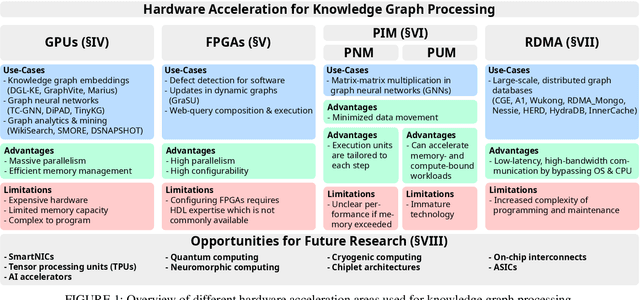
Abstract:Knowledge graphs (KGs) have achieved significant attention in recent years, particularly in the area of the Semantic Web as well as gaining popularity in other application domains such as data mining and search engines. Simultaneously, there has been enormous progress in the development of different types of heterogeneous hardware, impacting the way KGs are processed. The aim of this paper is to provide a systematic literature review of knowledge graph hardware acceleration. For this, we present a classification of the primary areas in knowledge graph technology that harnesses different hardware units for accelerating certain knowledge graph functionalities. We then extensively describe respective works, focusing on how KG related schemes harness modern hardware accelerators. Based on our review, we identify various research gaps and future exploratory directions that are anticipated to be of significant value both for academics and industry practitioners.
Multi-Head RAG: Solving Multi-Aspect Problems with LLMs
Jun 07, 2024Abstract:Retrieval Augmented Generation (RAG) enhances the abilities of Large Language Models (LLMs) by enabling the retrieval of documents into the LLM context to provide more accurate and relevant responses. Existing RAG solutions do not focus on queries that may require fetching multiple documents with substantially different contents. Such queries occur frequently, but are challenging because the embeddings of these documents may be distant in the embedding space, making it hard to retrieve them all. This paper introduces Multi-Head RAG (MRAG), a novel scheme designed to address this gap with a simple yet powerful idea: leveraging activations of Transformer's multi-head attention layer, instead of the decoder layer, as keys for fetching multi-aspect documents. The driving motivation is that different attention heads can learn to capture different data aspects. Harnessing the corresponding activations results in embeddings that represent various facets of data items and queries, improving the retrieval accuracy for complex queries. We provide an evaluation methodology and metrics, synthetic datasets, and real-world use cases to demonstrate MRAG's effectiveness, showing improvements of up to 20% in relevance over standard RAG baselines. MRAG can be seamlessly integrated with existing RAG frameworks and benchmarking tools like RAGAS as well as different classes of data stores.
CheckEmbed: Effective Verification of LLM Solutions to Open-Ended Tasks
Jun 04, 2024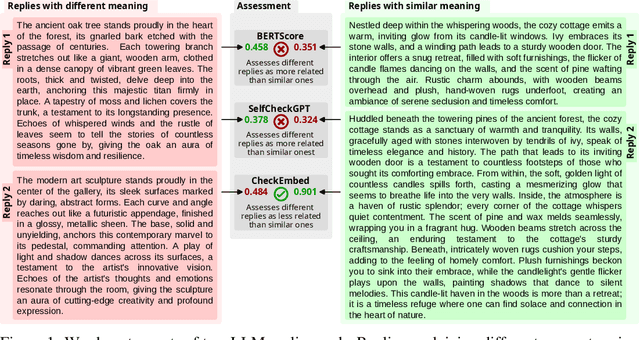
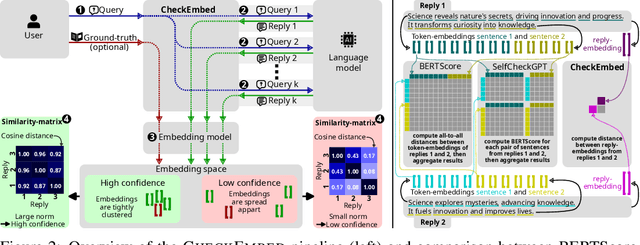
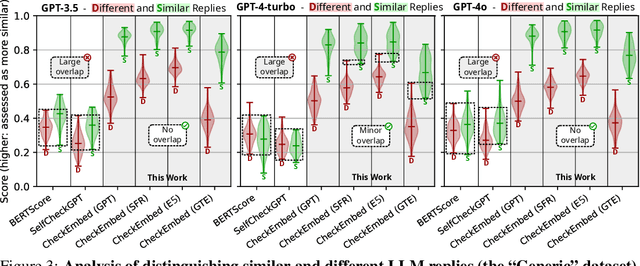
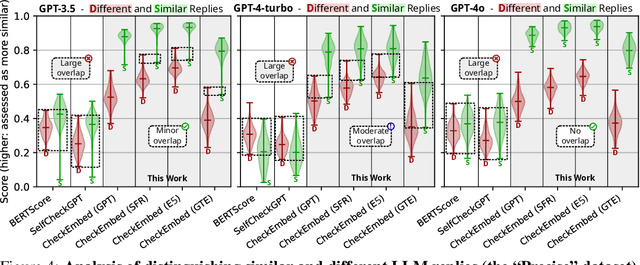
Abstract:Large Language Models (LLMs) are revolutionizing various domains, yet verifying their answers remains a significant challenge, especially for intricate open-ended tasks such as consolidation, summarization, and extraction of knowledge. In this work, we propose CheckEmbed: an accurate, scalable, and simple LLM verification approach. CheckEmbed is driven by a straightforward yet powerful idea: in order to compare LLM solutions to one another or to the ground-truth, compare their corresponding answer-level embeddings obtained with a model such as GPT Text Embedding Large. This reduces a complex textual answer to a single embedding, facilitating straightforward, fast, and meaningful verification. We develop a comprehensive verification pipeline implementing the CheckEmbed methodology. The CheckEmbed pipeline also comes with metrics for assessing the truthfulness of the LLM answers, such as embedding heatmaps and their summaries. We show how to use these metrics for deploying practical engines that decide whether an LLM answer is satisfactory or not. We apply the pipeline to real-world document analysis tasks, including term extraction and document summarization, showcasing significant improvements in accuracy, cost-effectiveness, and runtime performance compared to existing token-, sentence-, and fact-level schemes such as BERTScore or SelfCheckGPT.
Topologies of Reasoning: Demystifying Chains, Trees, and Graphs of Thoughts
Jan 25, 2024Abstract:The field of natural language processing (NLP) has witnessed significant progress in recent years, with a notable focus on improving large language models' (LLM) performance through innovative prompting techniques. Among these, prompt engineering coupled with structures has emerged as a promising paradigm, with designs such as Chain-of-Thought, Tree of Thoughts, or Graph of Thoughts, in which the overall LLM reasoning is guided by a structure such as a graph. As illustrated with numerous examples, this paradigm significantly enhances the LLM's capability to solve numerous tasks, ranging from logical or mathematical reasoning to planning or creative writing. To facilitate the understanding of this growing field and pave the way for future developments, we devise a general blueprint for effective and efficient LLM reasoning schemes. For this, we conduct an in-depth analysis of the prompt execution pipeline, clarifying and clearly defining different concepts. We then build the first taxonomy of structure-enhanced LLM reasoning schemes. We focus on identifying fundamental classes of harnessed structures, and we analyze the representations of these structures, algorithms executed with these structures, and many others. We refer to these structures as reasoning topologies, because their representation becomes to a degree spatial, as they are contained within the LLM context. Our study compares existing prompting schemes using the proposed taxonomy, discussing how certain design choices lead to different patterns in performance and cost. We also outline theoretical underpinnings, relationships between prompting and others parts of the LLM ecosystem such as knowledge bases, and the associated research challenges. Our work will help to advance future prompt engineering techniques.
Graph of Thoughts: Solving Elaborate Problems with Large Language Models
Aug 21, 2023



Abstract:We introduce Graph of Thoughts (GoT): a framework that advances prompting capabilities in large language models (LLMs) beyond those offered by paradigms such as Chain-of-Thought or Tree of Thoughts (ToT). The key idea and primary advantage of GoT is the ability to model the information generated by an LLM as an arbitrary graph, where units of information ("LLM thoughts") are vertices, and edges correspond to dependencies between these vertices. This approach enables combining arbitrary LLM thoughts into synergistic outcomes, distilling the essence of whole networks of thoughts, or enhancing thoughts using feedback loops. We illustrate that GoT offers advantages over state of the art on different tasks, for example increasing the quality of sorting by 62% over ToT, while simultaneously reducing costs by >31%. We ensure that GoT is extensible with new thought transformations and thus can be used to spearhead new prompting schemes. This work brings the LLM reasoning closer to human thinking or brain mechanisms such as recurrence, both of which form complex networks.
 Add to Chrome
Add to Chrome Add to Firefox
Add to Firefox Add to Edge
Add to Edge